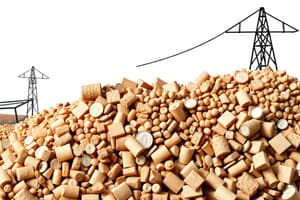Podcast
Questions and Answers
Within macroeconomics, what is the fundamental approach to understanding aggregate supply and demand?
Within macroeconomics, what is the fundamental approach to understanding aggregate supply and demand?
- Summing over all actors in microeconomics to derive aggregate measures. (correct)
- Analyzing only the largest firms to predict general economic trends.
- Using complex mathematical techniques without regard to underlying economic behaviors.
- Ignoring individual economic actors to focus on market outcomes.
In the context of the supply side of macroeconomics, what is the primary focus?
In the context of the supply side of macroeconomics, what is the primary focus?
- Analyzing how firms determine prices and production levels. (correct)
- Studying international trade agreements and their impact on exports.
- Understanding consumer behavior and demand drivers.
- Examining government policies that affect consumer spending.
What does a production function primarily describe?
What does a production function primarily describe?
- The relationship between inputs and outputs in a production process. (correct)
- The marketing strategies used to sell products.
- The financial performance of a company over time.
- The organizational structure of a manufacturing plant.
If $Y = AF(K, N)$ represents a production function, what does 'A' typically signify?
If $Y = AF(K, N)$ represents a production function, what does 'A' typically signify?
In production function analysis, diminishing returns to scale would imply what?
In production function analysis, diminishing returns to scale would imply what?
What does marginal product of labor (MPN) represent in economics?
What does marginal product of labor (MPN) represent in economics?
How is marginal cost (MC) related to the wage rate (W) and the marginal product of labor (MPN)?
How is marginal cost (MC) related to the wage rate (W) and the marginal product of labor (MPN)?
Under the assumption of monopolistic competition, firms set prices based on:
Under the assumption of monopolistic competition, firms set prices based on:
If a firm's pricing strategy is defined by $P = (1 + \mu)MC$, what does $\mu$ represent?
If a firm's pricing strategy is defined by $P = (1 + \mu)MC$, what does $\mu$ represent?
What is a key characteristic of the supply side in Keynesian macroeconomics?
What is a key characteristic of the supply side in Keynesian macroeconomics?
What critical implication arises from the assumption of sticky prices in the Keynesian model?
What critical implication arises from the assumption of sticky prices in the Keynesian model?
If 'u' represents the unemployment rate and 'L' the labor force, how is the number of employed workers 'N' expressed?
If 'u' represents the unemployment rate and 'L' the labor force, how is the number of employed workers 'N' expressed?
What does the equation $Y = F(K, (1-u)L)$ represent in the context of macroeconomics?
What does the equation $Y = F(K, (1-u)L)$ represent in the context of macroeconomics?
How does AKU (Arbeidskraftundersøkelsen) primarily measure unemployment?
How does AKU (Arbeidskraftundersøkelsen) primarily measure unemployment?
Which statement correctly describes the typical relationship between AKU-measured unemployment and registered unemployment?
Which statement correctly describes the typical relationship between AKU-measured unemployment and registered unemployment?
What does Okun's Law suggest about the relationship between GDP growth and unemployment?
What does Okun's Law suggest about the relationship between GDP growth and unemployment?
According to the content, what is the effect of productivity growth on employment levels?
According to the content, what is the effect of productivity growth on employment levels?
What is emphasized regarding wage adjustments in achieving full employment in the long run?
What is emphasized regarding wage adjustments in achieving full employment in the long run?
What is frictional unemployment?
What is frictional unemployment?
What does 'NAIRU' stand for, and what type of unemployment is absent at this level?
What does 'NAIRU' stand for, and what type of unemployment is absent at this level?
Flashcards
Product Function
Product Function
Summarizes production processes.
Input Factors
Input Factors
Inputs put into the production process to create macro goods.
Y = F(K,N)
Y = F(K,N)
Y = F(K,N) where Y is output, K is capital, and N is labor.
Y = A F(K,N)
Y = A F(K,N)
Signup and view all the flashcards
Diminishing Returns
Diminishing Returns
Signup and view all the flashcards
Constant Returns to Scale
Constant Returns to Scale
Signup and view all the flashcards
Increasing Returns to Scale
Increasing Returns to Scale
Signup and view all the flashcards
Marginal Product
Marginal Product
Signup and view all the flashcards
Marginal Cost
Marginal Cost
Signup and view all the flashcards
Marginal Product of Labor (MPN)
Marginal Product of Labor (MPN)
Signup and view all the flashcards
Markup Pricing
Markup Pricing
Signup and view all the flashcards
Monopolistic Competition
Monopolistic Competition
Signup and view all the flashcards
Short-Term Rigidities
Short-Term Rigidities
Signup and view all the flashcards
Aggregate Supply
Aggregate Supply
Signup and view all the flashcards
Keynesian Economics
Keynesian Economics
Signup and view all the flashcards
Unemployment Rate
Unemployment Rate
Signup and view all the flashcards
Labor Force
Labor Force
Signup and view all the flashcards
Okun's Law
Okun's Law
Signup and view all the flashcards
Frictional Unemployment
Frictional Unemployment
Signup and view all the flashcards
Structural unemployment
Structural unemployment
Signup and view all the flashcards
Cyclical unemployment
Cyclical unemployment
Signup and view all the flashcards
Study Notes
- These notes discuss production and supply in macroeconomics.
Supply and Demand in Macro
- Supply and demand are established concepts in microeconomics.
- These concepts are also used in macroeconomics, but the interpretations can differ slightly.
- Aggregate supply and aggregate demand can be obtained by summing over all actors in micro.
- Chapter 3 focuses on the supply side, while chapter 4 focuses on the demand side.
The Supply Side
- Introduces standard microeconomic concepts.
- Incorporates assumptions that make the analysis Keynesian.
- Focuses on how firms set prices.
- Firms use a markup on marginal cost to set prices.
- Short-term rigidities are also a factor.
Production Function
- Production processes are summarized by a production function.
- Input factors are put into a production process to generate a "macro good."
- Y = F (K,N), where Y is output, K is capital, and N is labor.
- Y = A F (K,N), where A is the level of technology is constant in the short-term.
- K and N could be disaggregated into different types of capital and labor.
Mathematical Forms
- Various functional forms can be assumed.
- Examples include Cobb-Douglas and linear functions.
Returns to Scale
- Returns to scale can be decreasing (diseconomies of scale).
- Returns to scale can be constant.
- Returns to scale can be increasing (economies of scale).
- The most likely return to scale at the margin should be considered.
Marginal Product/Marginal Cost
- Marginal product is the derivative of the production function with respect to one of the input factors.
- Marginal cost is the incremental cost of producing one additional unit.
- MK = W/ MPN, where W is wages and MPN is the marginal product of labor.
- Holding K constant while varying N, MPN is the extra production obtained; 1/MPN is the labor needed for one extra unit.
- W is the price of labor.
Assumption: Price Markup
- Assumes monopolistic competition.
- Pricing is determined by P = (1 + μ) ΜΚ where μ is the markup and MK is the marginal cost.
- μ can be interpreted as "elasticity" in demand.
The Supply Side in Keynesian Macro
- Firms set prices as a markup on marginal cost.
- Firms produce and sell what is demanded.
- Production changes occur without significant changes in product prices (rigid prices).
- Keynes' central assumption is that demand changes affect produced volume, not prices.
- This short-term assumption implies managing demand is politically important.
Production and Employment
- u = U/L, where L is the labor force and N is the employed.
- N = L - U = L - uL = (1 – u)L
- Y = F (K, (1-u)L)
Measuring Unemployment
- AKU: labor force survey.
- Registered unemployment (with or without people on employment schemes).
- AKU unemployment is usually higher than registered unemployment.
- Unemployment is measured as a percentage of the labor force.
- The labor force in Norway is about 3 million.
- Many people are outside the labor force, for example, on disability benefits.
- This complicating cross-country comparisons of unemployment.
- In late 2024, 74,100 people were registered as fully unemployed or seeking employment through labor market measures at NAV which makes up 2.5% of the workforce.
Growth and Full Employment
- Okun's Law: a higher growth rate in GDP lowers unemployment
- "One percentage point of higher growth in GDP gives a 0.25 percentage point reduction in unemployment."
- Productivity growth weakens employment, requiring new jobs to employ everyone.
- In the long-term equilibrium, wages adjust to ensure everyone is employed, regardless of the growth rate.
Types of Unemployment
- Frictional unemployment
- Structural unemployment
- Cyclical unemployment
- «Equilibrium unemployment» (NAIRU) – no cyclical unemployment
- Y-n = F (K, 1 – (u-n) L) - "Potential GDP" when u-n is zero.
Studying That Suits You
Use AI to generate personalized quizzes and flashcards to suit your learning preferences.





